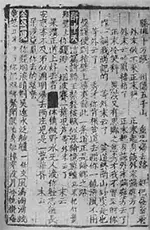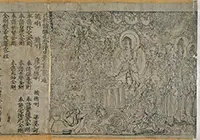Wood Block Printing in China
Printing with wood blocks is very old technology. The earliest known examples exist in Asian cultures, most prominently China, during the late Han period, in the 3rd Century. At that time, printers used silk and other cloth for their production. It was during the Tang period in China, about the 7th Century, that printing on paper using wood blocks became relatively common. 
To start with, the "writer" would use ink to create whatever needed to be copied on a sheet of fine paper. In most cases, this was writing; and because Chinese writing was done using characters, the things to be copied were not letters in the Western sense but characters in the Eastern sense. For the sake of efficiency, writers would fill the sheet of paper with characters, line by line. The next step was to press the sheet of paper to a wood block that had been coated with rice paste. (The wood was most commonly from a date or pear tree.) Pressing paper to paste-coasted wood transferred the inked images to the wood, and the consistency of the paste coating the wood was such that the paper did not stick to the wood. The characters on the sheet of paper, however, did stick to the wood, after a fashion, especially once the printer had used a strong brush to press the paper to the wood. The final step was to carve away the non-character bits of the block of wood so that all that remained was the writing. Any subsequent sheet of paper pressed onto the block of wood would have imprinted on it the characters on the wood. 
It wasn't always characters, of course. Anything else, like a drawing or a map or anything that an artist could create with ink, could be copied onto a wood block and then reproduced on a sheet of paper. (Cai Lun, in the 1st Century, had invented the first version of what we now call paper.) All of this meant that reproduction of crafted characters, artwork, and images could proceed at a faster rate than before. It took far less time to create one prototype of a page, impress the image of that page on a wooden block, and then press more sheets of papers onto that block, than it did to hand copy all of the characters, artwork, and images on each individual page. A typical text that would have taken months to reproduce could be copied in a matter of weeks. 
Chinese artists used this technique as a form of mass production, turning out all manner of written materials: calendars, notices, accounting tallies, government tax and legal records, and (of course) books. It was during the Tang period that Chinese officials produced the Diamond Sutra, the first full-length book complete with illustrations and text. The year of initial publication was 868. (This was not a book in the sense that modern readers would think of it; rather, the Diamond Sutra was a scroll that ran to 14 feet in length.) Books of poetry appeared by the hundreds, as did religious texts. It is perhaps for this reason that so many poems from the Tang period survive to this day. Later innovations in printing techniques allowed two sheets to be printed on one sheet and folded inwards; printers could paste together a collection of these at the fold and make a codex. Bindings were variously sewed or pasted. Printers at first used ink of only one color: black. Later generations added red and then other colors to their repertoire. The Indian and Japanese civilizations adopted practices of printing used wood blocks early on as well. The practice spread to Korea and then to Europe and the Middle East in subsequent centuries. |
|
Social Studies for Kids
copyright 2002–2024
David White




